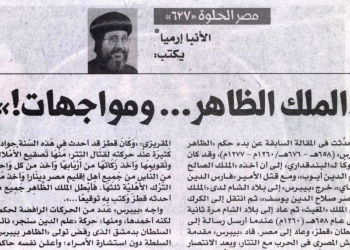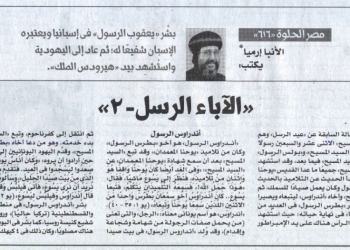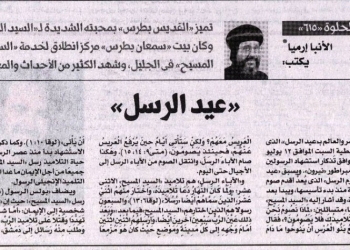In the previous article, we spoke of Mohammed al-Muntasir’s taking up the caliphate (247-248 Hijri) (861-862 A.D.) after his father’s murder, his deposing his brothers al-Mu’taz and al-Mu’ayyad, having abided by his commanders counsel. Yet, al-Muntasir’s tenure did not last, except for about six months. He got sick and died. Historians contended regarding the reasons of his death.
After his death, al-Mu’tasim’s grandson, al-Musta’in bellah became caliph (248-252 Hijri) (862-866 A.D.). Yet, it is said he was a make-believe ruler! Commanders conflicted, which resulted in turmoil. So much so that al-Musta’in fled to Baghdad with his associates Waseef and Bugha in 251 Hijri (865 A.D.) On the other hand, soldiers agreed to pledge allegiance to al-Mu’taz. Thus, there became two caliphs: al-Musta’in in Baghdad and al-Mu’taz in Samarra, only to start a series of conflicts between them affecting the provinces affiliated to the Abbasids, of which Egypt was one.
Each caliph commanded his affiliates to obey him and disobey his rival, which led to a great deal of tumult which, in turn, resulted in fighting between both. Al-Mu’taz got ready and prepared his troops to fight al-Musta’in. So, he sent them to Baghdad, led by his brother Ahmed bin al-Mutawakkil. War continued for a year (251 Hijri) (865 A.D.) during which Baghdad witnessed seditions and tumults until al-Musta’in and al-Mu’ayyad agreed to reconcile, provided that al-Musta’in abdicate.
This was fulfilled, and al-Musta’in pledged allegiance to al-Mu’taz in 252 Hijri (866 A.D.) Thus, his caliphate lasted for two years and nine months which extended to three years and six months when he was deposed. Then, al-Musta’in moved from Baghdad to Wasit before a year where he was killed before one year had elapsed. Historians disagreed regarding the manner of his assassination. Taghribirdi writes that al-Mu’taz asked Ahmed bin Toulon, a Turk, to kill him, but he refused, saying, “No, I swear to God never to kill caliphs’ offspring.” Al-Mu’taz answered, “Take him to Sa’id al-Hajib, which he did. Sa’id al-Hajib put him to death in Shawwal.” Al-Tabari writes, “While al-Mu’taz was playing chess, Sa’id bin Salih brought him al-Musta’in’s head and said, ‘This is the head of the deposed.’ So, he said, ‘Put it there.’ Having finished the game, he had it brought over, looked at it, then ordered its burial. Then he gave Sa’id fifty thousand dirhams and assigned him the affairs of al-Basra.”
The State’s Affairs during al-Musta’im’s Tenure
The Abbasid State became exceedingly tumultuous. Rebellions broke out in several regions, including an Alawite’s rebellion in kufa, another’s in Tapuria. Likewise, a revolution broke out in Sistan and the Arab’s provinces. Mosul became tumultuous as well. So did Palestine, Homs, Isfahan, and others.
The Yazids
Yahya bin Umar bin Yahya bin Yazid bin Ali bin al-Hussein rebelled in Kufa. Many Arabs joined him. He was able to ransack Kufa. So, Mohammed bin Abdullah bin Tahir sent a great army commanded by bin Mus’ab who was shrewd at warfare. He overcame the rebels, killed a large number of them, and killed Yahya in 250 Hijri (864 A.D.), sending Caliph al-Musta’in his head who ordered its hanging on one of the gates of Samarra. Yet, he restored it to Baghdad, for people revolted. Yet, the people of Baghdad revolted as well. So, he had the head put into a casket and kept in the weaponry house.
In Tapuria, al-Hussein bin Zaid bin Mohammed rebelled against the Abbasid State. According to al-Tabari, his rebellion was ascribed to the fact that al-Musta’in granted Mohammed bin Tahir a piece of Tapuria. When the latter sent a Jabir bin Harun to acquire the piece of land, he wanted to acquire a larger portion. So, the people arouse, and the Daylamites joined them to fight the ruler. They made al-Hussein bin Zaid their leader. He and the rebels ransacked Amol, which strengthened them, and others joined them. So, they marched to Saria, ousted its ruler, then Ray. Thus, al-Hussein bin Zaid found a Zaidi state in Tapuria which lasted for a century.
As for the external affairs, war was still going on between the Abbasids and Romans. During al-Musta’in’s tenure, the Romans were triumphant in Asia Minor. They killed many sentries as well as two of the best commanders in 249 Hijri (863 A.D.). Yet, the Caliph and his sentries were too preoccupied with conspiracies to mind the matter.
Caliph Abu Abdullah al-Mu’taz (252-255 Hijri) (866-869 A.D.)
Beforehand, we tackled his reign after al-Musta’in’s deposition in 252 Hijri (866 A.D.) Historians maintain that the Turks’ dominion increased during his tenure in such a way that he could not appoint a minister or scribe or depose them. Likewise, assassinations increased during his tenure due to the increase in conflicts amongst sentries. Thus, everybody became preoccupied with conspiracies, and the state’s affairs were uncared for.
At the beginning of his tenure, Turks asked him to pardon Waseef and Bugha, which he reluctantly did. He gave them back their possessions and posts. Yet, because the state’s affairs were uncared for, conflicts broke out in Baghdad and Samarra amongst the Moroccan and Turkish sentries, whereby the former asked for equality in posts and influence, which resulted in incessant conflict. Moroccans snatched the tax-collection authority from the Turks, thus realizing what they wanted. Yet, the Turks restored it and murdered Moroccan commanders. In 253 Hijri (863 A.D.), Turks, Moroccans and Persians demanded a four-month pay, which Waseef refused. So, they rebelled and killed him.
So, the Caliph appointed Bugha in his stead, but the latter rebelled. So, a Salih took over. At that time, Salih became friendly to commander Baikbak, and they split the state’s affairs between them. Baghdad witnessed a lot of riot between her proconsul Mohammed bin Abdullah bin Tahir and the sentries. Wars broke out between them. Sentries were victorious at first. Yet, this did not last for long, as Mohammed bin Tahir overcame them and killed their leader, which appeased the country for a while.
At that time, Egypt was greatly affected. Stories never end in Beautiful Egypt.
General Bishop
Head of the Coptic Orthodox Cultural Center


 العربية
العربية











